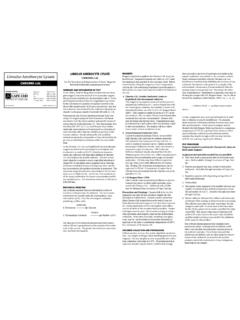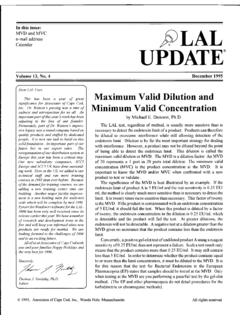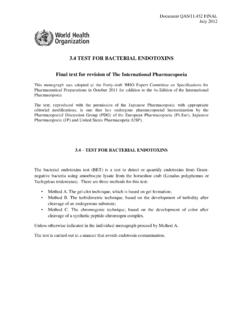Transcription of Changes in European Endotoxin Testing …
1 Changes in European Endotoxin Testing regulations and guidance By Mick Dawson April, 2017 BET White Paper Associates of Cape Cod, Inc., East Falmouth, MA 02536 ~ ~ PR# 17-012 Changes in European Endotoxin Testing regulations and guidance _____ April, 2017 BET White Paper PR# 17-012 Associates of Cape Cod, Inc., East Falmouth, MA, 2 Introduction Between 2014 and 2016 the European Pharmacopoeia Commission announced Changes regarding Endotoxin Testing . First, in late 2014 and early 2015 the Commission issued a new policy on bacterial Endotoxin Testing . Second, in October 2014 planned revisions were published to the European Pharmacopoeia (Ph. Eur.) informational chapter Guidelines for Using the Test for Bacterial endotoxins ( ).
2 These two documents and their significance are discussed in turn below. In addition, minor Changes regarding endotoxins are being made to the Ph. Eur. monograph on Substances for Pharmaceutical Use. These Changes have significant implications for Endotoxin Testing of some products being distributed in the European market. They became effective in mid-2016. IMPORTANT: The information in this article summarizes information given in regulatory documents. It is not intended to be, and it should not be used as a substitute for the original documents. Decisions and actions should be based upon a clear understanding of the original regulations , guidance documents and pharmacopeial chapters, not on this article.
3 New Policy on Bacterial Endotoxin Testing The most important point in the policy is that most new monographs, including those for parenteral products or substances, will not include a requirement for the bacterial endotoxins test (BET) or an Endotoxin specification. The policy was announced in September 2014 when the European Pharmacopoeia Commission published the first version of the policy, which was titled Bacterial endotoxins Ph. Eur. policy for substances for pharmaceutical use1. It was revised somewhat in February 2015 in a doc-ument with a modified title: European Pharmacopoeia policy on bacterial endotoxins in substances for pharmaceutical use2.
4 While a number of Changes were made in the February 2015 version, the essentials of the policy remain. The key elements of the new policy are as follows: 1. New monographs for substances for pharmaceutical use will generally not include a requirement for the bacterial endotoxins test (BET). A requirement for a BET will only be included in monographs in specific cases, such as when a particular sample preparation or test method has to be used. Instead of specifying the BET in each future monograph, the requirement for a BET will be addressed globally by two general monographs in the European Pharm-acopoeia. One is Substances for pharmaceutical use (2034), which requires compliance with BET for substances offered as a bacterial Endotoxin -free grade.
5 Manufacturers will have to refer to this monograph to determine whether a bacterial endotoxins test is required. ( Changes to the Substances for pharmaceutical use monograph are discussed below.) The other monograph, Parenteral preparations (0520), clearly states that pharmaceutical preparations that are to be used parenterally shall comply with the BET. 2. In addition to not including a requirement for the BET, most new monographs for substances for pharmaceutical use will not include an Endotoxin limit specification either. Manufacturers will be responsible for determining the limit used in Endotoxin tests based on consideration of the use of the substance, including the route of administration and patient population, the dose of the product, manufacturing process capability and any other considerations raised by the competent authority.
6 The policy refers to Ph. Eur. chapter Guidelines for Using the Test for Bacterial endotoxins ( ) for calculation of Endotoxin limits. The inclusion of manufacturing process capability in the considerations for setting limits suggests Changes in European Endotoxin Testing regulations and guidance _____ April, 2017 BET White Paper PR# 17-012 Associates of Cape Cod, Inc., East Falmouth, MA, 3 that Endotoxin limits should be set as low as reasonably possible; not just as low as they need to be based on the calculation. The policy only applies to new monographs. The requirement for a BET and current Endotoxin limits are retained in existing monographs for substances for pharmaceutical use.
7 The new policy explicitly places responsibility on manufacturers. In order to determine the need for, and the numerical value of, Endotoxin limits for substances for pharmaceutical use, manufacturers will need to have a thorough understanding of the types of substance or product for which a BET is required and of the principles involved in setting Endotoxin limits. The final (February 2015) version of the policy noted that the requirements for a BET apply to the finished product, as is specified in the monograph, Parenteral preparations (0520). To achieve this, the manufacturer can use substances that comply with the BET and/or demonstrate ( validate) that the process includes a procedure for the removal of Endotoxin .
8 Caution Regarding Interpretation of the Policy It is important to remember that the ultimate goal of Endotoxin Testing is to assure that a patient does not receive a pyrogenic dose of Endotoxin when given the maximum dose of the finished dosage form of a parenterally administered therapeutic substance. Consequently, the sum of any Endotoxin in the various components of that dosage form must not exceed the Endotoxin limit. Substances for pharmaceutical use are defined in the monograph on the subject as any organic or inorganic substances that are used as active substances or excipients for the production of medicinal products for human or veterinary use.
9 That is, it includes all of the components of the finished dosage form. Both the new policy on bacterial endotoxins and the monograph on Substances for pharmaceutical use refer to chapter Guidelines for Using the Test for Bacterial endotoxins the calculation of Endotoxin limits. If the Endotoxin limit calculation given in is applied to each of the components of a pharmaceutical formulation in turn, the individual components might each meet an Endotoxin limit calculated as specified in the chapter Guidelines. However, if two or more of those components (whether active substance or excipient) contain sufficient Endotoxin , the complete formulation could fail to meet the Endotoxin specification for the product.
10 This point is made in the new section 2-4 in the Ph. Eur. Guidelines chapter (which is discussed below) and is also alluded to in the United States Food and Drug Administration (FDA) guidance on Pyrogen and endotoxins Testing : Questions and Answers3. In order to assure that the combined components of the formulation do not cause the Endotoxin limit of the finished drug product to be exceeded, the Endotoxin limit for the finished dosage form must be divided between the various components. Consequently, the limits for the components will be lower than limits calculated as if each component were to be administered alone. A description of how to assign Endotoxin limits to each of the components of a product is beyond the scope of this article and is addressed elsewhere4.












